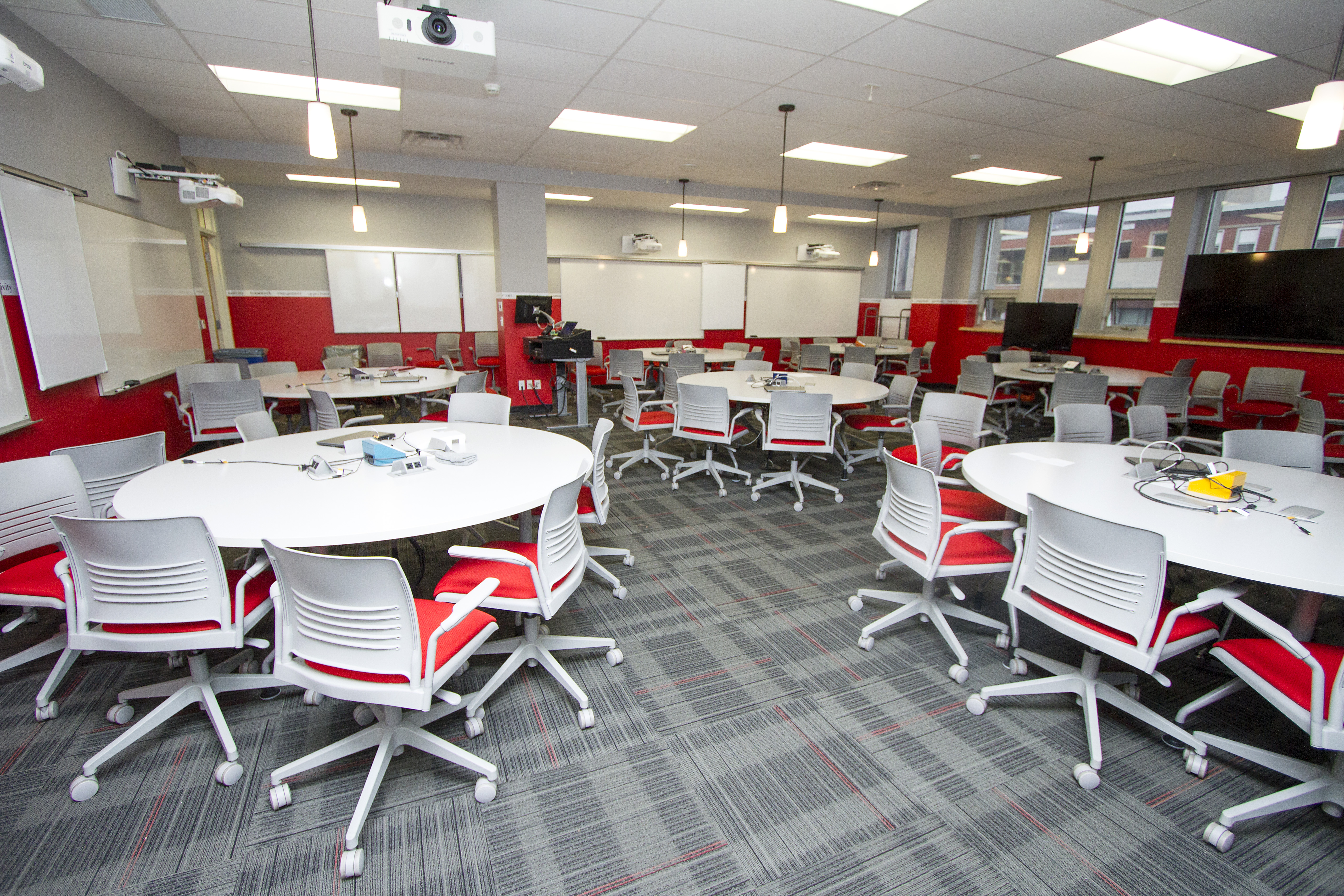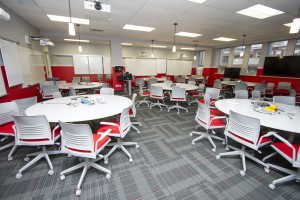Classrooms become interactive

In Sept. 2012, the first active learning classroom at Laurier was created in DAWB 3-106, which has a 40-person capacity.

When Mercedes Rowinsky came to Wilfrid Laurier University’s dean of arts office two and a half years ago, dean of arts Mike Carroll asked her if she had any ideas to enhance students’ learning experience.
Rowinsky, the associate dean of student affairs and special projects, thought about McGill University and their active learning classrooms, and asked Carroll how much funding he had for special projects.
“He had a bit of funding, but then we contacted the [vice-president] academic and the teaching support services, and both of them collaborated on the first classroom,” Rowinsky recounted.
In Sept. 2012, the first active learning classroom at Laurier was created in DAWB 3-106, which has a 40-person capacity.
The classroom is meant to make the learning experience interactive with an emphasis on group work and discussion. They have circular tables with a laptop at each that connects to one of the projector screens around the room, removable white boards that can be brought to the tables for groups to work and projector screens that function as smart boards.
This past summer, the faculty of arts put funding toward a second larger active learning classroom in DAWB 2-104, which can hold 72 students.
“There is definitely a link between the physical space of the classroom and what the space conveys to students about the activities that space is meant to encourage,” said Sally Heath, manager of academic program development and review, and a partner on the project. “A lot of our classrooms, if you think about them, all of the seats are facing the front with the instructor at the centre … suggesting that all that’s really supposed to happen is that you’re supposed to sit and you’re supposed to listen.”
The technology and physical space in the active learning classrooms is meant to support more flexible and active learning.
“I think it opens up the opportunity to have a closer relationship because you really have the opportunities to chat with students, to have discussions and give formative feedback [to students] instead of summative,” Rowinsky explained.
Heath and teaching support services put together an annual report after the first year of the first active learning classroom to view feedback from faculty and students. Feedback found that student participation increased and classes “felt like a conversation,” and was very positive overall.
However, challenges were noted, such as professors having trouble with technology, suggesting further training for faculty and/or students.
Heath said Michael Daly, quality assurance coordinator in teaching support services, takes care of the faculty orientation and training in the active learning classrooms.
“The very first term of the first room, there was a bit of a learning curve for sure,” Heath said.
Eleanor Ty, a professor in the department of English and film studies, is teaching a first-year seminar called “The Monsters We Imagine” in the active learning classroom in DAWB 2-104.
“I think it gives [the students] a more relaxed atmosphere and it puts more onus on them to find stuff on their own and talk amongst themselves.
The way it enhances [the experience] is that it is less of a student-teacher [dynamic]. Instead of a rigid space, it’s a more relaxed learning space,” she said.
Ty said that although the classrooms work well for group work and discussion-based courses, they are not as useful for heavy lecture-based material. As a result, she gives her students an essay to read in their table groups or an assignment to work on, and they can put together a
PowerPoint slide to portray their findings to the rest of the class.
Isti Kery, a fourth-year global studies student, has GS405X — War, Memory and Popular Culture — in DAWB 3-106. He is required to do a group presentation and will be using the six projector screens to simulate a war environment in the classroom. However, for the remainder of his presentation, he will be lecturing from the front.
“For my sake, I’m taking a global studies course where it’s very much lecture-based and I don’t find it’s that valuable,” he said.
Kery did emphasize that the true value in the active learning classrooms isn’t necessarily the technology but the ability to sit at round tables with other students.
“Sitting in those types of environments where you’re talking with people, it creates a lot of really good discussion and I really got to know all of the people at my table, which makes me want to be in that class.”
Rowinsky said there is progress to make the active learning classrooms available through Laurier’s learning experience. There will be another active learning-type classroom in the new Global Innovation Exchange building, and the university is in the planning stages for another to open in Brantford next September.
“Laurier is moving forward in the right direction and we should be grateful funding has been allocated for this project,” Rowinsky said. “Because I think it’s changing the way we do things.”


